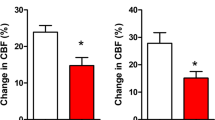Abstract
The dose of radiation that safely can be administered to patients with malignant gliomas is limited by the potential for severe CNS morbidity. Manipulations that might increase the radiation sensitivity of gliomas and/or decrease injury to normal components of the CNS, e.g., the microvascular endothelium, one of the cell types believed to play a major role in radiation myelopathy, would provide a therapeutic benefit. One such approach may be the use of polyunsaturated fatty acids (PUFAs). PUFAs can inhibit tumor cell growth both in vitro 1 and in vivo 2. Moreover, Vartak et al.3, have recently shown that PUFAs are not only selectively cytotoxic to glioma cells, but also enhance the radiosensitivity of glioma cells. PUFAs have also been shown to reduce the severity of radiation-induced injury to normal tissue such as skin4 and CNS5. The damaging effects of ionizing radiation are due mainly to the generation of reactive oxygen species (ROS) which alter cell proteins, lipids and DNA. Therefore, we hypothesize that PUFAs may modify the response of cells to ionizing radiation by altering antioxidant enzymes that scavenge ROS. One such antioxidant enzyme, manganese Superoxide dismutase (Mn-SOD), a member of the Superoxide dismutase family of enzymes which scavenge Superoxide radicals, has been shown6,7 to protect a variety of cells from ionizing radiation. In addition, several studies have shown8,9 that PUFAs can alter Mn-SOD message, protein and activity. Therefore, we determined if one such PUFA, eicosapentaenoic acid (EPA; 20:5n-3), could alter Mn-SOD in a normal CNS-derived microvascular endothelial cell and a malignant CNS-derived glioma cell line.
Access this chapter
Tax calculation will be finalised at checkout
Purchases are for personal use only
Preview
Unable to display preview. Download preview PDF.
Similar content being viewed by others
References
Gonzalez, M.J., Schemmel, R.A., Dugan, Jr.,L., Gray, J.I. and Welsch, C.W. Dietary fish oil inhibits human breast carcinoma growth: a function of increased lipid peroxidation. Lipids 28:827–832 (1993).
Karmali, R.A., Reichel, P., Cohen, L.A., Terano, T., Hirai, A., Tamura, Y. and Yoshida, S. The effect of dietary n-3 fatty acids on the DU-145 transplantable human prostatic cancer. Anticancer Res. 7:1173–1180 (1987).
Vartak, S., Robbins, M.E.C. and Spector, A.A. Polyunsaturated fatty acids increase the sensitivity of 36B10 rat astrocytoma cells to radiation-induced cell kill. Lipids 32:283–292 (1997).
Hopewell, J.W., van den Aardweg, G.J.M.J., Morris, G.M., Rezvani, M., Robbins, M.E.C, Ross, G.A., Whitehouse, E.M., Scott, C.A. and Horrobin, D.F. Amerlioration of both early and;ate radiation-induced damage to pig skin by essential fatty acids. Int. J. Radial Oncol. Biol. Phys. 30:1119 (1994).
Hopewell, J.W., van den Aardweg, G.J.M.J., Morris, G.M., Rezvani, M., Robbins, M.E.C., Ross, G.A., Whitehouse, E.M. In: New Approaches to Cancer Treatment: Unsaturated Lipids and Photodynamic Therapy, D.F. Horrobined., Churchill Comm. Europe, London (1994).
Wong, G.H. Protective roles of cytokines against radiation: induction of mitochondrial Mn-SOD. Biochim. Biophys. Acta. 1271:205 (1995).
Juan, S., Yuan, C., Mei, Z., Mingtao, L. and Zhongliang, G. Mitochondrial alterations in CHO cells exposed to X-ray after transfecting with human MnSOD cDNA. MedSci. Res. 25:81 (1997).
Venkatraman, J.T., Chandrasekar, B., Kim, J.D. and Fernandes, G. Effects of n-3 and n-6 fatty acids on the activities and expresssion of hepatic antioxidant enzymes in autoimmune-prone NZBxNZW Fl mice. Lipids 29:561 (1994).
Phylactos, A.C., Harbige, L.S. and Crawford, M.A. Essential fatty acids alter the activity of manganese-superoxide dismutase in rat heart. Lipids 29:111 (1994).
Debault, L.E., Henriquez, E., Hart, M.N. and Cancilla, P.A. Cerebral microvessels and derived cells in tissue culture II. Establishment, identification, and preliminary characterization of an endothelial cell line. In Vitrc 17:480 (1981).
Spence, A.M., Coates, P.W. Scanning electron microscopy of cloned astrocytic lines derived from ethyl-nitrosourea-induced rat glioma. Virchows Arch. B: 28, 27 (1978).
Folch, J., Lees, M.B. and Sloane Stanley, G.H. A simple method for the isolation and purification of total lipids from animal tissues. J. Biol. Chem. 226:497 (1957).
Morrison, W.R., Smith, M.L. Preparation of fatty acid methyl esters and dimethylacetals from lipids with boron fluoride-methanol. J. Lipid Res. 5:600 (1964).
Laemmli, U.K. Cleavage of structural proteins during the assembly of the head of bacteriophage T4. Nature. 227:680 (1970).
Monkuno, K., Ohtani, K., Suzumura, A., Kiyosawa, K., Hirose, Y., Kawai, K. and Kato, K. Induction of manganese Superoxide dismutase by cytokines and lipopolysaccharide in cultured mouse astrocytes. J. Neurochem. 63:612 (1995).
Visner, G.A., Chesrown, S.E., Monnier, J., Ryan, U.S. and Nick, H.S. Regulation of manganese Superoxide dismutase: 11-1 and TNF induction in pulmonary artery and microvascular endothelial. Biochem. Biophys. Res. Commun. 188:453 (1992).
Bravard, A., Sabatier, L., Hoffschir, F., Ricoul, M., Luccioni, C., Dutrillax, B. SOD2: a new type of tumor-suppressor gene? Int. J. Cancer. 51:476 (1992).
Yoshioka, T., Homma, T., Meyrick, B., Takeda, M., Moore-Jarret, T., Kon, V. and Ichikawa, I. Oxidants induce transcriptional activation of manganese Superoxide dismutase in glomerular cells. Kidney Int. 46:405 (1994).
Willumsen, N., Vaagenes, H., Lie, O., Rustan, A. and Berge, R.K. Eicosapentaenoic acid, but not docosahexaenoic acid, increases mitochondrial fatty acid oxidation and upregulates 2,4-dienoyl-CoA reductase gene expression in rats. Lipids 31:579 (1996).
Benzi, G., Moretti, A. Age-and peroxidative stress-related moficications of the cerebral enzymatic activities linked to mitochondria and the glutathione system. Free Radic. Biol. Med. 19:77 (1995).
Brand, K.A. and Hermfisse, U. Aerobic glycolysis by proliferating cells: a protective strategy against reactive oxygen species. FASEB J. 11:388 (1997).
Author information
Authors and Affiliations
Editor information
Editors and Affiliations
Rights and permissions
Copyright information
© 1999 Springer Science+Business Media New York
About this chapter
Cite this chapter
Girnun, G.D., Oberley, L.W., Moore, S.A., Robbins, M.E.C. (1999). Eicosapentaenoic Acid Alters Manganese Superoxide Dismutase Immunoreactive Protein Levels in Normal But not Maligant Central Nervous System Derived Cells. In: Honn, K.V., Marnett, L.J., Nigam, S., Dennis, E.A. (eds) Eicosanoids and Other Bioactive Lipids in Cancer, Inflammation, and Radiation Injury, 4. Advances in Experimental Medicine and Biology, vol 469. Springer, Boston, MA. https://doi.org/10.1007/978-1-4615-4793-8_93
Download citation
DOI: https://doi.org/10.1007/978-1-4615-4793-8_93
Publisher Name: Springer, Boston, MA
Print ISBN: 978-1-4613-7171-7
Online ISBN: 978-1-4615-4793-8
eBook Packages: Springer Book Archive




